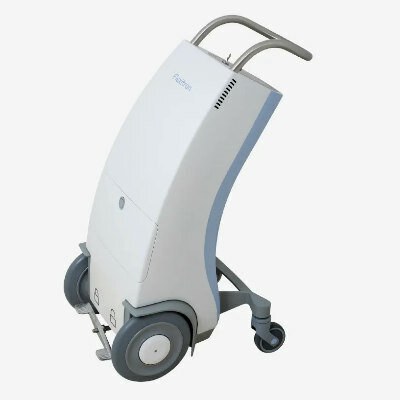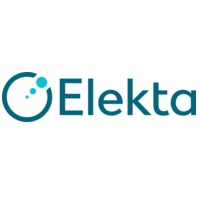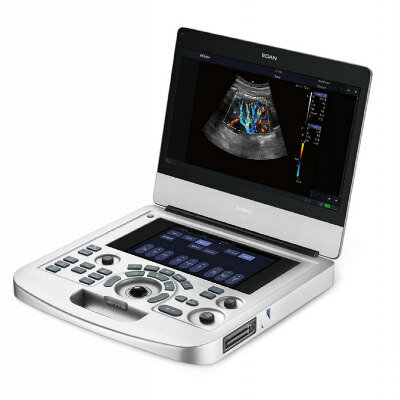SBRT Improves NSCLC Survival Rates in Elderly Patients
|
By MedImaging International staff writers Posted on 14 Oct 2016 |

Image: An example of dose distribution of SBRT for lung cancer (Photo courtesy of the NIH).
Survival rates of elderly patients with early-stage non-small cell lung cancer (NSCLC) have risen dramatically over the past decade, concurrent with the increasing adoption of stereotactic body radiation therapy (SBRT), according to a new study.
Researchers at Houston Methodist Hospital (HMH; Houston, TX, USA), Baylor College of Medicine (Houston, TX, USA), and other institutions reviewed the medical records of 62,213 patients age 60 and above who were diagnosed with stage I NSCLC between 2004 and 2012, as extracted from the U.S. Surveillance, Epidemiology, and End Results (SEER) database. The patients were grouped into five-year subsets (60-64; 65-69; 70-74; 75-79; 80-84; 85-89; and 90 and older), and overall survival (OS) and lung cancer-specific survival rates were then calculated to draw population-based comparisons between SBRT and surgery alone.
The results showed that from 2004 to 2012--the years in which adoption of SBRT in community practice became widespread--the OS rate at 23 months following SBRT alone rose from 39 to 58%; OS rates for surgery alone rose from 79 to 84%. In the same time period, cancer-specific survival increased from 48 to 72% of patients who received SBRT alone, and from 87 to 91% of patients receiving surgery alone. Cancer-specific survival rates remained stable for patients who received neither surgery nor radiation.
Analysis revealed that the use of surgery to treat stage I NSCLC declined with age. While 81% of patients age 60-64 underwent surgery, only 47% of patients age 80 or older were able to undergo surgery. The use of SBRT, conversely, rose with increasing age, ranging from 11% of patients age 60-64 to 39% of patients age 90 or above. The number of patients receiving no treatment also increased, from 7 to 40% for the youngest and oldest elderly patient cohorts in the study. The study was presented at the 58th annual meeting of the American Society for Radiation Oncology (ASTRO), held during September 2016 in Boston (MA, USA).
“While survival rates remain highest for surgical candidates, this study demonstrates both clear benefits from SBRT for nonsurgical NSCLC patients and that outcomes following radiation therapy have improved at a more accelerated pace over the past decade than those for any other therapeutic approach,” said senior author Andrew M. Farach, MD, of Baylor College of Medicine. “With continued adoption of SBRT in community cancer centers, it is our hope that more patients will receive curative SBRT and the number of patients left untreated based on age or medical comorbidity will continue to fall.”
SBRT is emerging as an attractive option for treating cancers in the lung, head and neck, prostate, liver and other disease sites, with the objective of increasing local control of the target lesion while limiting dose to nearby critical structures and normal tissue. Requirements include precise localization of the target lesion in the treatment planning process; accounting for tumor motion due to respiration or other changes in the body; highly conformal dose distribution to the target volume, including a steep dose gradient to minimize radiation to surrounding healthy tissue; and image-guidance at the time of dose delivery for verification and adjustment of the target localization.
Related Links:
Houston Methodist Hospital
Baylor College of Medicine
Researchers at Houston Methodist Hospital (HMH; Houston, TX, USA), Baylor College of Medicine (Houston, TX, USA), and other institutions reviewed the medical records of 62,213 patients age 60 and above who were diagnosed with stage I NSCLC between 2004 and 2012, as extracted from the U.S. Surveillance, Epidemiology, and End Results (SEER) database. The patients were grouped into five-year subsets (60-64; 65-69; 70-74; 75-79; 80-84; 85-89; and 90 and older), and overall survival (OS) and lung cancer-specific survival rates were then calculated to draw population-based comparisons between SBRT and surgery alone.
The results showed that from 2004 to 2012--the years in which adoption of SBRT in community practice became widespread--the OS rate at 23 months following SBRT alone rose from 39 to 58%; OS rates for surgery alone rose from 79 to 84%. In the same time period, cancer-specific survival increased from 48 to 72% of patients who received SBRT alone, and from 87 to 91% of patients receiving surgery alone. Cancer-specific survival rates remained stable for patients who received neither surgery nor radiation.
Analysis revealed that the use of surgery to treat stage I NSCLC declined with age. While 81% of patients age 60-64 underwent surgery, only 47% of patients age 80 or older were able to undergo surgery. The use of SBRT, conversely, rose with increasing age, ranging from 11% of patients age 60-64 to 39% of patients age 90 or above. The number of patients receiving no treatment also increased, from 7 to 40% for the youngest and oldest elderly patient cohorts in the study. The study was presented at the 58th annual meeting of the American Society for Radiation Oncology (ASTRO), held during September 2016 in Boston (MA, USA).
“While survival rates remain highest for surgical candidates, this study demonstrates both clear benefits from SBRT for nonsurgical NSCLC patients and that outcomes following radiation therapy have improved at a more accelerated pace over the past decade than those for any other therapeutic approach,” said senior author Andrew M. Farach, MD, of Baylor College of Medicine. “With continued adoption of SBRT in community cancer centers, it is our hope that more patients will receive curative SBRT and the number of patients left untreated based on age or medical comorbidity will continue to fall.”
SBRT is emerging as an attractive option for treating cancers in the lung, head and neck, prostate, liver and other disease sites, with the objective of increasing local control of the target lesion while limiting dose to nearby critical structures and normal tissue. Requirements include precise localization of the target lesion in the treatment planning process; accounting for tumor motion due to respiration or other changes in the body; highly conformal dose distribution to the target volume, including a steep dose gradient to minimize radiation to surrounding healthy tissue; and image-guidance at the time of dose delivery for verification and adjustment of the target localization.
Related Links:
Houston Methodist Hospital
Baylor College of Medicine
Latest Nuclear Medicine News
- New SPECT/CT Technique Could Change Imaging Practices and Increase Patient Access
- New Radiotheranostic System Detects and Treats Ovarian Cancer Noninvasively
- AI System Automatically and Reliably Detects Cardiac Amyloidosis Using Scintigraphy Imaging
- Early 30-Minute Dynamic FDG-PET Acquisition Could Halve Lung Scan Times
- New Method for Triggering and Imaging Seizures to Help Guide Epilepsy Surgery
- Radioguided Surgery Accurately Detects and Removes Metastatic Lymph Nodes in Prostate Cancer Patients
- New PET Tracer Detects Inflammatory Arthritis Before Symptoms Appear
- Novel PET Tracer Enhances Lesion Detection in Medullary Thyroid Cancer
- Targeted Therapy Delivers Radiation Directly To Cells in Hard-To-Treat Cancers
- New PET Tracer Noninvasively Identifies Cancer Gene Mutation for More Precise Diagnosis
- Algorithm Predicts Prostate Cancer Recurrence in Patients Treated by Radiation Therapy
- Novel PET Imaging Tracer Noninvasively Identifies Cancer Gene Mutation for More Precise Diagnosis
- Ultrafast Laser Technology to Improve Cancer Treatment
- Low-Dose Radiation Therapy Demonstrates Potential for Treatment of Heart Failure
- New PET Radiotracer Aids Early, Noninvasive Detection of Inflammatory Bowel Disease
- Combining Amino Acid PET and MRI Imaging to Help Treat Aggressive Brain Tumors
Channels
Radiography
view channel
Novel Breast Imaging System Proves As Effective As Mammography
Breast cancer remains the most frequently diagnosed cancer among women. It is projected that one in eight women will be diagnosed with breast cancer during her lifetime, and one in 42 women who turn 50... Read more
AI Assistance Improves Breast-Cancer Screening by Reducing False Positives
Radiologists typically detect one case of cancer for every 200 mammograms reviewed. However, these evaluations often result in false positives, leading to unnecessary patient recalls for additional testing,... Read moreMRI
view channel
PET/MRI Improves Diagnostic Accuracy for Prostate Cancer Patients
The Prostate Imaging Reporting and Data System (PI-RADS) is a five-point scale to assess potential prostate cancer in MR images. PI-RADS category 3 which offers an unclear suggestion of clinically significant... Read more
Next Generation MR-Guided Focused Ultrasound Ushers In Future of Incisionless Neurosurgery
Essential tremor, often called familial, idiopathic, or benign tremor, leads to uncontrollable shaking that significantly affects a person’s life. When traditional medications do not alleviate symptoms,... Read more
Two-Part MRI Scan Detects Prostate Cancer More Quickly without Compromising Diagnostic Quality
Prostate cancer ranks as the most prevalent cancer among men. Over the last decade, the introduction of MRI scans has significantly transformed the diagnosis process, marking the most substantial advancement... Read moreUltrasound
view channel
Deep Learning Advances Super-Resolution Ultrasound Imaging
Ultrasound localization microscopy (ULM) is an advanced imaging technique that offers high-resolution visualization of microvascular structures. It employs microbubbles, FDA-approved contrast agents, injected... Read more
Novel Ultrasound-Launched Targeted Nanoparticle Eliminates Biofilm and Bacterial Infection
Biofilms, formed by bacteria aggregating into dense communities for protection against harsh environmental conditions, are a significant contributor to various infectious diseases. Biofilms frequently... Read moreGeneral/Advanced Imaging
view channel
New AI Method Captures Uncertainty in Medical Images
In the field of biomedicine, segmentation is the process of annotating pixels from an important structure in medical images, such as organs or cells. Artificial Intelligence (AI) models are utilized to... Read more.jpg)
CT Coronary Angiography Reduces Need for Invasive Tests to Diagnose Coronary Artery Disease
Coronary artery disease (CAD), one of the leading causes of death worldwide, involves the narrowing of coronary arteries due to atherosclerosis, resulting in insufficient blood flow to the heart muscle.... Read more
Novel Blood Test Could Reduce Need for PET Imaging of Patients with Alzheimer’s
Alzheimer's disease (AD), a condition marked by cognitive decline and the presence of beta-amyloid (Aβ) plaques and neurofibrillary tangles in the brain, poses diagnostic challenges. Amyloid positron emission... Read more.jpg)
CT-Based Deep Learning Algorithm Accurately Differentiates Benign From Malignant Vertebral Fractures
The rise in the aging population is expected to result in a corresponding increase in the prevalence of vertebral fractures which can cause back pain or neurologic compromise, leading to impaired function... Read moreImaging IT
view channel
New Google Cloud Medical Imaging Suite Makes Imaging Healthcare Data More Accessible
Medical imaging is a critical tool used to diagnose patients, and there are billions of medical images scanned globally each year. Imaging data accounts for about 90% of all healthcare data1 and, until... Read more
Global AI in Medical Diagnostics Market to Be Driven by Demand for Image Recognition in Radiology
The global artificial intelligence (AI) in medical diagnostics market is expanding with early disease detection being one of its key applications and image recognition becoming a compelling consumer proposition... Read moreIndustry News
view channel
Bayer and Google Partner on New AI Product for Radiologists
Medical imaging data comprises around 90% of all healthcare data, and it is a highly complex and rich clinical data modality and serves as a vital tool for diagnosing patients. Each year, billions of medical... Read more





















